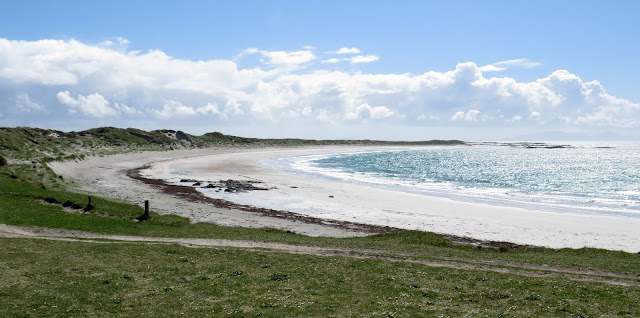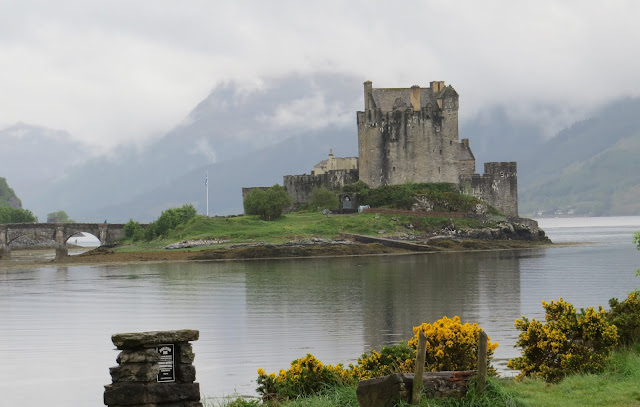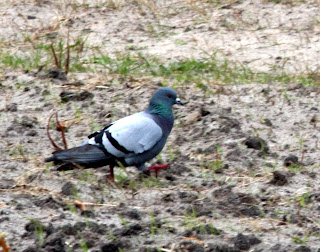Full House
Tuesday May 9
In Africa they have the Big Five to target. Mull has the Favourite Four. Our day out with Arthur Brown, who with his wife Pam runs '' Discover Mull'', is much anticipated and always enjoyed. Arthur was a Shropshire dairy farmer until he came to Mull and started his wildlife tours in the north of the island, based in Dervaig.
We parked at his house, as did four other participants, before leaving to pick up two others from the Bellachroy Inn. Very conveniently, a pair of White-tailed Eagles have built a nest a mere quarter of a mile from Arthur's house. All we could see to-day was the top of the sitting bird's head. The Forestry Commission was in the middle of felling this particular patch of forest when the Eagles moved in. They then had to stop felling - a reversal of the usual process. The birds must have accepted the logging as part of normality around them, building their nest without fear.
With regular pauses for refreshment, home-made biscuits of three varieties and a drink for elevenses, a mug of soup and four varieties of sandwiches at lunchtime, three choices of cake and a drink in the afternoon, the day sped by. The weather was, again, sunny all day but with a bitingly cold wind. The soup was welcome.
The first viewing of one of the Fav 4 was head only. The second was a magnificent flying view at Loch na Keal. We were stopped, keeping an eye on the Lady Jane, a boat tour where fish is fed to the eagle - if it arrives. Nothing was seen until a male White-tailed Eagle appeared low over our heads giving everyone stunning views.
The second, Golden Eagle, was also on the shores of Loch na Keal whilst we lunched. Arthur had said that the nest changeover time was between 12.30 and 1.30 - although he hadn't seen one yesterday. To-day's was at 1.10 ish. Not extensive views and fairly distant but, very satisfactory for all.
Loch na Keal is Mull's deepest sea loch and is where the British Fleet anchored before leaving for Scapa Flow. Where it meets the open sea a huge Roche Moutonee can be seen, a remnant of the Ice Age.
In glaciology, a rôche moutonnée (or sheepback) is a rock formation created by the passing of a glacier.
The passage of glacier ice over underlying bedrock often results in
asymmetric erosional forms as a result of abrasion on the "stoss"
(upstream) side of the rock and plucking on the "lee" (downstream) side.
These erosional features are seen on scales of less than a metre to
several hundred metres.
The 18th-century Alpine explorer Horace-Bénédict de Saussure coined the term rôches moutonnées in 1786. He saw in these rocks a resemblance to the wigs that were fashionable amongst French gentry in his era and which were smoothed over with mutton fat (hence moutonnée) so as to keep the hair in place.[1] The French term is often incorrectly interpreted as meaning "sheep rock".
A little further on is the Island of Inch Kenneth, where Nancy Mitford , one of the infamous Mitford sisters died. She fell in love with Hitler, tried to commit suicide, damaged herself and was brought to the island, where she succumbed to meningitis and died.
Calgary Bay, a white shell sand, perfectly curved bay backed by machair and framed by a turquoise sea, was at its most beautiful. It's one of those sights which is breathtaking, however often you see it.
An apparent dry stone wall leading vertically towards the shore on the opposite hillside is an Isostatic Rebound or volcanic dyke. No, me neither!
A raised shoreline is an ancient shoreline exposed above current water level.[1] These landforms are formed by a relative change in sea level due to global sea level rise, isostatic rebound, and/or tectonic uplift. These surfaces are usually exposed above modern sea level when a heavily glaciated area experiences a glacial retreat, causing water levels to rise. This area will then experience post-glacial rebound, effectively raising the shoreline surface.
Examples of raised shorelines can be found along the coasts of formerly glaciated areas in Ireland[2] and Scotland, as well as in North America.
Examples of raised shorelines can be found along the coasts of formerly glaciated areas in Ireland[2] and Scotland, as well as in North America.
So there !!
Despite the heat haze, the lighthouse on the point of the Ardnamurchan peninsula loomed dimly. This is the westernmost point of mainland UK. Arthur is a fund of historical, geographical and geological information. Useful in slack periods.
Loch na Keal mouth is also where we saw our third Fav, Otter. Arthur hasn't seen one for days, the Knock Bridge closure has cut off the most favoured spot. To-day's highly acclaimed sighting was first made by a group member. Again, Arthur has only seen an Otter here on a handful of occasions.
The Bluebells are fantastic this year as the cold spring has delayed the bracken growth enabling the flowers to appear in all their glory. A wood near the McQuarie mausoleum was spectacular.
Two more Golden Eagles from a viewpoint high in the moors, delight all round. Another fly-by Cuckoo sighting too, a fully silent one. The rest of the group, in common with most of Arthur's customers, are bonly really interested in seeing Eaglrs and Otters. They should have been satisfied to-day - especially with the added bonus of Atlantic Grey Seals and Red Deer.
We were told that the Mountain Hare population appears to have been decimated. There are still plenty of Hares, they've become much warier and secretive since the White-tailed Eagle introduction. Official ringers of the eagles' chicks report ''plenty of hares'' around the nests.
Pam and I were delighted with the Greenshank on Loch Cuin, our first of the trip. So was Arthur.
We were told that the Mountain Hare population appears to have been decimated. There are still plenty of Hares, they've become much warier and secretive since the White-tailed Eagle introduction. Official ringers of the eagles' chicks report ''plenty of hares'' around the nests.
We are considering self catering on Mull next year. With this in mind, we asked to see Arthur and Pam's places. One is a bed/sit/kitchen for two, the other the real deal with two bedrooms which is lovely. Great views, including a feeder where a pair of Redpoll were feeding. Very tempted.
So where's Number Four of the Fav Four? After saying goodbye, Pam and I drove the very hilly with many S bends road, from Dervaig to Tobermory, parking at the Loch Frisa track. We've been lucky here before, not to-day. WE left after half an hour as it was getting late.
As we approached the top of the steep road leading to Dervaig below, a superb male Hen Harrier flew past, over the hillside and away. Lovely.
The male Hen nHarriers have up to three females. The Alpha Female is well cared for and tended, the second is assisted if there's time. The third usually has to fend for herself during chick brooding and fledging (Arthur).
The male Hen nHarriers have up to three females. The Alpha Female is well cared for and tended, the second is assisted if there's time. The third usually has to fend for herself during chick brooding and fledging (Arthur).
Super day, thank you the Browns.



Comments
Post a Comment